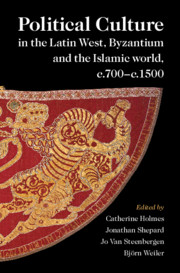 Political Culture in the Latin West, Byzantium and the Islamic World, c.700–c.1500
Political Culture in the Latin West, Byzantium and the Islamic World, c.700–c.1500 Book contents
- Political Culture in the Latin West, Byzantium and the Islamic World, c.700–c.1500
- Political Culture in the Latin West, Byzantium and the Islamic World, c.700–c.1500
- Copyright page
- Contents
- Figures and Maps
- Contributors
- Preface and Acknowledgements
- Abbreviations
- General Maps
- 1 Political Culture in Three Spheres
- 2 Reflections on Political Culture in Three Spheres
- Part I Sources
- 3 Comparing the Three Spheres through the Prism of the Sources
- 4 The Latin West
- 5 Byzantium
- 6 The Islamic World
- Part II Historical Contexts
- Part III Norms, Values and Their Propagation
- Part IV Practice and Organisation
- Part V Conclusions
- Appendix
- Glossary
- Index
6 - The Islamic World
Sources
from Part I - Sources
Published online by Cambridge University Press: 11 August 2021
- Political Culture in the Latin West, Byzantium and the Islamic World, c.700–c.1500
- Political Culture in the Latin West, Byzantium and the Islamic World, c.700–c.1500
- Copyright page
- Contents
- Figures and Maps
- Contributors
- Preface and Acknowledgements
- Abbreviations
- General Maps
- 1 Political Culture in Three Spheres
- 2 Reflections on Political Culture in Three Spheres
- Part I Sources
- 3 Comparing the Three Spheres through the Prism of the Sources
- 4 The Latin West
- 5 Byzantium
- 6 The Islamic World
- Part II Historical Contexts
- Part III Norms, Values and Their Propagation
- Part IV Practice and Organisation
- Part V Conclusions
- Appendix
- Glossary
- Index
Summary
The Qurʾan, and the problems of its interpretation, is even more central to Islamic political culture than is the Bible to the Latin west and Byzantium. It became accepted in the mid-ninth century that interpretation of the law and many case rulings should be the preserve of the ʿulamaʾ. So although the caliph was revered as the guardian of the faith and supreme leader, his rule was not engrained in the courts of law and the maintenance of property rights and inheritance in the manner of western or Byzantine rulers. This partly accounts for the relatively poor survival rate of archival holdings. Yet narratives and prescriptive texts can shed light on actual practices and help chart change over time, from the caliphate’s imperial palaces to the predominance of Turco-Mongol warlords in the later middle ages. Evidence is particularly full for the Ilkhan rulers of Iran and those of Egypt and Transoxania. Their entourages brought new ideas and practices to Islamic political culture without abandoning core elements of Islamic ideology. The Ottomans’ conquest of Asia Minor and, above all, of Constantinople created the most enduring blend of Islamic traditions and new modes of rulership.
- Type
- Chapter
- Information
- Political Culture in the Latin West, Byzantium and the Islamic World, c.700–c.1500A Framework for Comparing Three Spheres, pp. 101 - 130Publisher: Cambridge University PressPrint publication year: 2021


